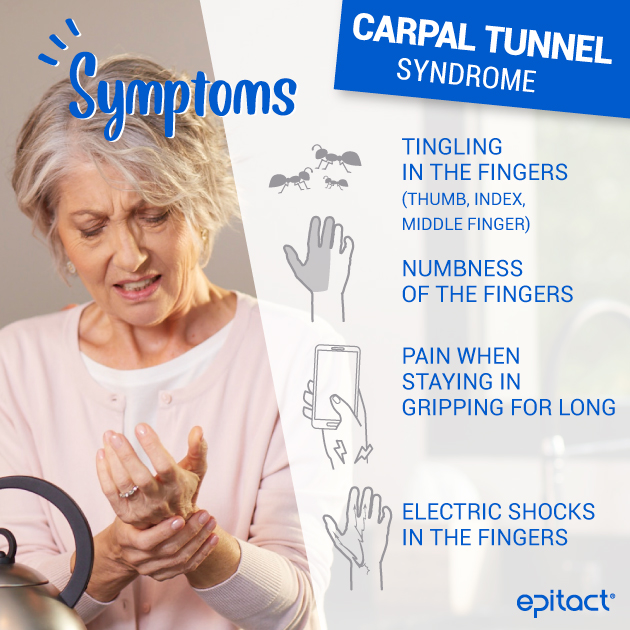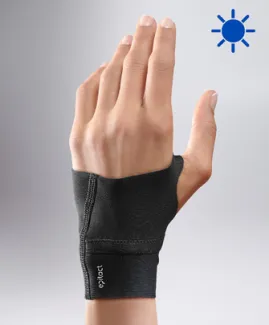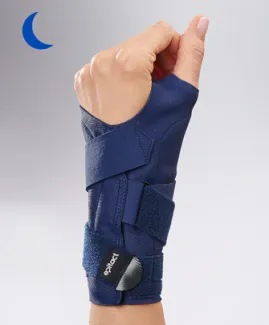
Carpal tunnel syndrome (CTS) is a set of symptoms caused by the compression of the median nerve inside the carpal tunnel. It appears and progresses slowly, from simple discomfort to intense pain and disabling symptoms at advanced stages. There is a classification in 4 stages of the signs and symptoms of carpal tunnel syndrome: stage 0 to stage 3.
Discover the early, mild, and severe signs of CTS and how to reduce these symptoms.
Nature and location of the symptoms of carpal tunnel syndrome
CTS occurs when the median nerve is under prolonged pressure. This nerve runs along the forearm, continues in the inner half of the palm, and ends in the four first fingers: thumb, index, middle finger, and half of the ring finger.
Its role is to give sensitivity to the skin and muscles in this area. This is why the symptoms of carpal tunnel syndrome appear in your hand and fingers, and include pain, pins and needles, numbness, loss of sensitivity and loss of strength.
Carpal tunnel syndrome: symptoms at night
Symptoms of CTS are usually more intense at night because of the prolonged extreme flexions or extensions of the wrist you do unconsciously during your sleep. Many people also sleep with the hand under the pillow, causing prolonged pressure on the median nerve. They progressively stop when you move your wrist again or shake your hand. As you change your position, the compression reduces along with the symptoms.
If left untreated, carpal tunnel syndrome may disturb your sleep and gradually reduce your quality of life.
Symptoms during the day
Symptoms of carpal tunnel syndrome in the hand can also appear during the day. Indeed, many recreational or occupational activities involve inappropriate wrist position: repetitive or prolonged twisting, flexion and extension of the wrist, precise movements that require strength (e.g.: ironing, reading…).
Combined with cold temperatures or vibrations, these factors highly contribute to developing the symptoms of carpal tunnel syndrome and reduce your abilities to do your daily activities.
Can CTS go away spontaneously?
The symptoms can manifest discontinuously, with periods of attacks and periods of calm. Also, they can disappear spontaneously, especially if you improve your postural habits. During pregnancy, the symptoms of carpal tunnel syndrome in the hands usually develop in the third quarter and disappear after childbirth.
To better understand what triggers such symptoms, discover all the causes of carpal tunnel syndrome.

The 4 stages of carpal tunnel syndrome
The signs and symptoms of CTS appear progressively. In the beginning, they only occur at night but over time they can also come during the day and become permanent. In the more advanced stages of carpal tunnel syndrome, you may suffer insomnia, sensory and motor deficits, with weakness and then atrophy of certain muscles in the hand.
Stage 0
Unsurprisingly, this stage of carpal tunnel corresponds to a stage in which patients are asymptomatic(1).
Stage 1: the early signs of carpal tunnel
Stage 1 or mild stage of carpal tunnel syndrome include the early signs of the disease. It is characterised by pins and needles, numbness and electric discharge sensations in the area of the median nerve(2, 3). This nerve extends over a large part of the palm of the hand, in the first three fingers and the internal side of the fourth. The sensory disorders are irregular and can wake you up at night with the sensation that your hand is swollen and stiff(3).
These symptoms often disappear when the patient reactivates blood circulation, for example by shaking the hand, a manoeuvre known as Flick's sign(4). Indeed, nerve compression leads to a reduction in microcirculation in the median nerve(5).
Stage 2 : moderate CTS
Stage 2, or moderate stage, is characterised by continuous symptoms(1). They are felt both at night and during the day after repeated intense activity of the hand and wrist. They are also aggravated by a loss of dexterity and grip strength in the hand and fingers(3). They may also be accompanied by problems of tactile sensitivity, particularly at the end of the first three fingers.
Stage 3 : severe carpal tunnel syndrome
Finally, the advanced or severe carpal tunnel syndrome corresponds to stage 3. This stage is characterised by permanent impairment of sensory and motor functions, with atrophy of the thenar and hypothenar eminences(6). Damage to the nerve can lead to a decrease or loss of strength in these muscles, located at the base of each side of the palm of the hand. This makes it difficult, if not impossible, for you to hold an object so you suddenly drop it(7). This symptom is visible and is responsible for the "monkey hand" phenomenon. This stage therefore reflects significant sensitivity abnormalities with an inability to grab things(5).
Sometimes CTS is classified in 5 stages
Some authors classify the symptoms of carpal tunnel syndrome into 5 stages(8, 9). Stages 1 and 2 are the early signs of CTS and affect most patients. Stage 1 is characterised by nocturnal tingling and stage 2 by nocturnal and daytime tingling. In stage 3, known as moderate carpal tunnel, the patient suffers from sensitivity problems in the area innervated by the median nerve. In the advanced stages of carpal tunnel, stages 4 and 5, there are muscular problems. Thus, in stage 4 you have weakness in the muscles at the base of the thumb, and in stage 5, atrophy and/or paralysis of these muscles.
How to reduce the signs and symptoms of carpal tunnel syndrome?
In a third of cases, carpal tunnel syndrome disappears on its own. These are people who develop the condition because of a temporary factor (for example pregnant women after giving birth or stopping unusual wrist activity)(2). Most of the time, CTS requires medical treatment, and in a few cases a surgical intervention.
Treatment at the early signs of carpal tunnel
In the two first stages of CTS, you should be prescribed a medical treatment. It first consists of limiting the activity that may trigger your symptoms. As a complement, your doctor may recommend immobilising your wrist thanks to a splint, at least at night(10). CARP’IMMO™* is a rigid splint that keeps your wrist straight. Its spiral adjustment strap ensures that the brace fits snugly around your wrist without putting pressure on the carpal tunnel.
During the day, we recommend you wear a flexible brace, which is compatible with your activities. EPITACT® has created CARP’ACTIV™*. It combines a specific design and a technical fabric that support your wrist and limit risky movements. For round-the-clock action, take advantage of a special offer with the day & night wrist braces by EPITACT®*!
In addition to braces, physiotherapy and medication are recommended. If these treatments are insufficient, your GP may prescribe 2 to 3 corticosteroid injections within the carpal tunnel. If this fails again, the next option is surgery.
Relieving the pain of severe carpal tunnel syndrome
If you have severe symptoms of carpal tunnel syndrome or if medical treatments have failed, surgery is indicated(8). This involves cutting the transverse carpal ligament to free the median nerve. The later the condition is treated, the greater the risk of damage to the nerve and the longer it will take to recover from surgery. At an advanced stage, recovery may take several months and may be incomplete(5).
At both the mild and severe stage of carpal tunnel syndrome, symptoms are very disabling and progressively reduce your ability to do daily activities and your quality of life. You understand the importance of consulting a doctor as soon as the first signs and symptoms of carpal tunnel syndrome appear. Now discover a few tips to prevent the symptoms of carpal tunnel syndrome.
*These solutions are medical devices that bear the CE marking under this regulation. Carefully read the instructions before use. Manufacturer: MILLET Innovation. 04/2024
Sources:
(1)Haute Autorité de Santé. Chirurgie du syndrome du canal carpien : approche multidimensionnelle pour une décision pertinente [Internet]. 2012 p. 146. Report No.: Rapport d’évaluation technologique.
(2)Haute Autorité de Santé. Syndrome du canal carpien : optimiser la pertinence du parcours patient [Internet]. 2013.
(3)Yunoki M, Kanda T, Suzuki K, Uneda A, Hirashita K, Yoshino K. Importance of Recognizing Carpal Tunnel Syndrome for Neurosurgeons: A Review. Neurol Med Chir(Tokyo). 2017;57(4):172 83.
(4)Gueneau J. Analyse de la masso-kinésithérapie chez les patients atteints du syndrome du canal carpien léger ou modéré. Hand Surgery and Rehabilitation. 1 déc 2019;38(6):453.
(5)Chammas M. Bases physiopathologiques de la prise en charge des syndromes de compression des nerfs périphériques. La Lettre du Rhumatologue. 2002;282:15 21.
(6)Kanatani T, Fujioka H, Kurosaka M, Nagura I, Sumi M. Delayed Electrophysiological Recovery After Carpal Tunnel Release for Advanced Carpal Tunnel Syndrome: A Two-Year Follow-Up Study. Journal of Clinical Neurophysiology. févr 2013;30(1):95.
(7)Ameli. Symptômes, diagnostic et évolution du syndrome du canal carpien [Internet]. ameli.fr. 2022. Disponible sur: https://www.ameli.fr/assure/sante/themes/syndrome-canal-carpien/symptomes-diagnostic-evolution
(8)Mondelli M, Farioli A, Mattioli S, Aretini A, Ginanneschi F, Greco G, et al. Severity of Carpal Tunnel Syndrome and Diagnostic Accuracy of Hand and Body Anthropometric Measures. PLOS ONE. 21 oct 2016;11(10):e0164715.
(9)Mondelli M, Passero S, Giannini F. Provocative tests in different stages of carpal tunnel syndrome. Clinical Neurology and Neurosurgery. 1 oct 2001;103(3):178 83.
(10)Petrover D, Richette P. Prise en charge du syndrome du canal carpien: de l’échographie diagnostique à la libération percutanée sous échographie. Revue du Rhumatisme. 1 mai 2018;85(3):243 50.
 Pharmacie
Pharmacie

